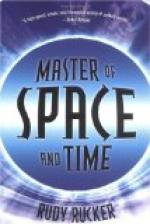The systems best adapted to rapid telegraph work are predicated on the use of a perforated tape on which, by means of a suitable perforating apparatus, little round holes are produced in various groupings, each group, when the tape is passed through the transmitter, causing a certain combination of electrical impulses to pass over the wire. The transmitter as a rule consists of a mechanically or motor driven mechanism which causes the telegraph impulses to be transmitted to the line, and the combination and character of the impulses are determined by the tape perforations. The rapidity with which the tape may be driven through the transmitter makes very high speed operation possible. Of course it is necessary that there should be at the other end of the wire apparatus capable of receiving and recording the signals as speedily as they are sent.
As early as 1848 Alexander Bain perfected a system involving the use of the perforated transmitting tape; at the receiving station the messages were recorded in dots and dashes upon a chemically prepared strip of paper by means of iron pens, the metal of which was, through the combined action of the electrical current and the chemical preparation, decomposed, producing black marks in the form of dots and dashes upon the paper. The Bain apparatus was in actual operation in the younger days of the telegraph. Various systems, based on similar principles, involving tape transmission and the production of dots and dashes on a receiving tape, have from time to time been devised, but have generally not succeeded in establishing any permanent usefulness in competition with more effective instrumentalities which have been perfected.
The hardiest survivor of them is the Wheatstone apparatus, which has been in successful operation for years. Originally the perforating—or, to use the commonly current term, the punching—of the Wheatstone sending tape was accomplished by a mechanism equipped with three keys—one for the dot, one for the dash, and one for the space. The keys were struck with rubber-tipped mallets held in the hands of the operator and brought down with considerable force. Later this rather primitive perforator was supplanted by one equipped with a full keyboard on the order of a typewriter keyboard. At the receiving end of the line the messages are produced on a tape in dots and dashes of the Morse alphabet, and hence a further process of translation is necessary. This system has proven very useful, particularly in times of wire trouble and scarcity of facilities, when it is essential to move as many messages as possible over the available lines.
The schemes devised for combining automatic transmission by the perforated-tape method with direct production of the message at its destination in ordinary letters and figures, eliminating the intervening step of translation from Morse characters, have been many. Their individual enumeration is beyond the scope of the present discussion, and would in any event involve a wearisome exposition of their distinguishing technical features. Several of these systems are at present in practical and very effective operation.




